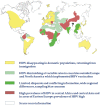A Review of HDV Infection
- PMID: 36016371
- PMCID: PMC9414459
- DOI: 10.3390/v14081749
A Review of HDV Infection
Abstract
Hepatitis D is the most severe viral hepatitis. Hepatitis D virus (HDV) has a very small RNA genome with unique biological properties. It requires for infection the presence of hepatitis B virus (HBV) and is transmitted parenterally, mainly by superinfection of HBsAg carriers who then develop chronic hepatitis D. HDV has been brought under control in high-income countries by the implementation of HBV vaccination, and the clinical pattern has changed to a chronic hepatitis D seen in ageing patients with advanced fibrotic disease; the disease remains a major health concern in developing countries of Africa and Asia. Every HBsAg-positive subject should be tested for HDV serum markers by reflex testing, independently of clinical status. Vaccination against HBV provides the best prophylaxis against hepatitis D. The only therapy available so far has been the poorly performing Interferon alfa; however, several new and promising therapeutic approaches are under study.
Keywords: Kolmioviridae; anti-HD; bulevirtide; hepatitis D; hepatitis D virus.
Conflict of interest statement
The authors declare no conflict of interest.
Figures






References
-
- Rizzetto M., Canese M.G., Aricò S., Crivelli O., Trepò C., Bonino F., Verme G. Immunofluorescence detection of new antigen-antibody system (delta/anti-delta) associated to hepatitis B virus in liver and in serum of HBsAg carriers. Gut. 1977;18:997–1003. doi: 10.1136/gut.18.12.997. - DOI - PMC - PubMed
-
- Gerin J.L. The Taxonomy of Hepatitis Delta Virus. In: Nishioka K., Suzuki H., Mishiro S., Oda T., editors. Viral Hepatitis and Liver Disease. Springer; Tokyo, Japan: 1994. pp. 63–64.
Publication types
MeSH terms
Substances
LinkOut - more resources
Full Text Sources
Medical

